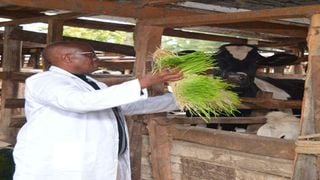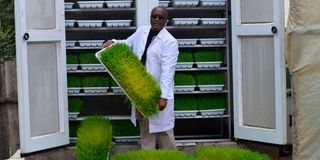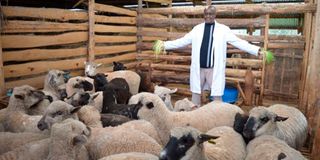
Peter Muturi Gicheha feeds his dairy cow with hydroponically grown maize fodder at his Cool Blue farm in Nyandarua County.
| Francis Mureithi | Nation Media GroupSeeds of Gold
Premium
My cows thrive on hydroponics fodder
What you need to know:
- Muturi keeps 50 dairy cows, which he feeds the maize fodder that he farms using the hydroponics feed machine.
- He borrowed the hydroponics technology from a farm in Uttar Pradesh, India during a visit in November 2016.
A massive steel gate welcomes one at Cool Blue Farm in Mumoi, North Kinangop, Nyandarua County.
One can only imagine what lies inside the walls that hold the gate, which are designed to keep intruders at bay.
But Seeds of Gold team does not wait for long before farmer Peter Gicheha Muturi opens the doors, to usher us into his 17-acre farm.
Inside the compound, gadgets that resemble massive refrigerators are strategically positioned near the main house.
“These are not refrigerators,” Muturi offers before we ask. “They are my farm, this is where I grow my fodder using the hydroponics system.”
Muturi keeps 50 dairy cows, which he feeds the maize fodder that he farms using the hydroponics feed machine.
“We mix the hydroponically grown maize with dry matter and concentrates to make a palatable meal that has boosted our milk production,” he says, noting he sells the milk to major processors and households at between Sh35 and Sh45 a litre.
Apart from dairy farming, Muturi keeps 45 Hampshire sheep and 29 Galla goats in the mixed farming venture.
He borrowed the hydroponics technology from a farm in Uttar Pradesh, India during a visit in November 2016.

Peter Muturi at his Cool Blue Farm in Nyandarua County with maize fodder for his animals.
“Though my farm is big, I saw the technology as godsend as it allows one to maximise on land use. Dairy farmers in India are doing well on their small land using the technology.”
The electric machine that can also be solar-powered, he says, is operated by one person saving a farmer labour costs.
To grow fodder, one must use maize seeds that are not treated. The seeds, at least 2kg, should be soaked in a bucket full of water for 24 hours.
They are then transferred into a gunny bag where they stay for between 30-36 hours for germination to take place after two days.
"We later put them into the hydroponics machine and spread in a tray, each holding 2kg.”
The trays are put in the upper deck of the machine, which has 84 slots. The machine has pipes that sprinkle water in the trays to speed up germination. “It senses when the plants need water and activates the sprinkler to water them.” The trays are rotated as the seeds grow and after seven to nine days, the fodder is ready for feeding to cows and any other animal.
The method of fodder production, according to Muturi, is best-suited for zero-grazing farmers who may have challenges with space.
"With this machine, land is spared for other purposes like growing vegetables and potatoes," says Muturi, adding farmers in Kitui, Machakos, Makueni, Isiolo and Garissa, among other dry places, can use it to keep dairy cows and goats.

Peter Muturi with his sheep at his farm in Nyandarua.
The smallest machine is 10 feet by 15 feet and has a height of 10 feet while the biggest is 30 feet by 10 feet with a height of 10 feet
The smallest machine can produce fodder for six cows every day while others, depending on size, can sustain 10, 30, 50 as well as 100 animals.
"The cost of the hydroponics machine varies depending on the size, from Sh1.5 million to Sh1.7 million. In my case I imported it directly from India,” says Muturi, who sells rams for Sh40,000 while Galla bucks go for Sh25,000.
Dr James Ombiro Ondiek, a senior lecturer at the Department of Animal Science at Egerton University, says farmers should use clean planting materials when growing crops using hydroponics method.
"The system requires seeds that are not treated with any chemicals. They should first be cleaned thoroughly using running water," says Dr Ondiek, adding the growing fodder should be sprinkled with water at least three times a day.
He notes that hydroponically grown maize contains all nutrients including proteins, carbohydrates, vitamins and minerals as the animals eat the whole plant including the roots.
Other fodder crops that can be grown using the same method include oat, barley and wheat.
According to Muturi, the benefits of hydroponics in dairy farming include reduction in land usage, water use, feed costs by 40 per cent, there is continuous production of fodder throughout the year, improved animal fertility, contamination of the fodder is eliminated and labour costs are drastically reduced.





